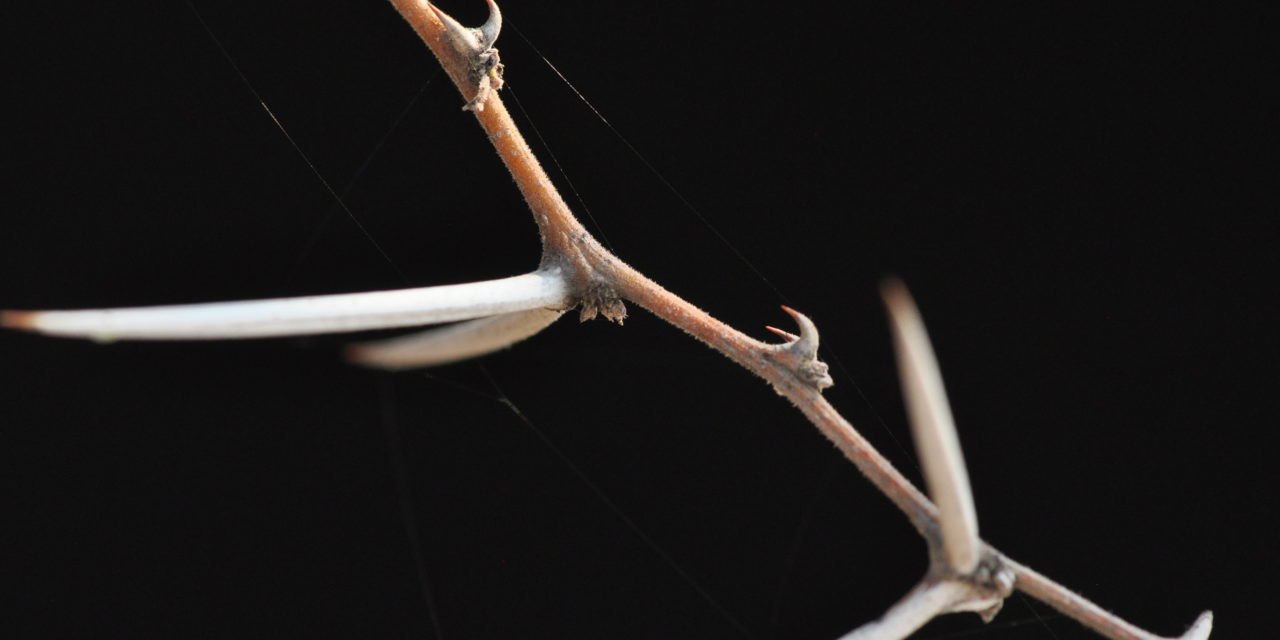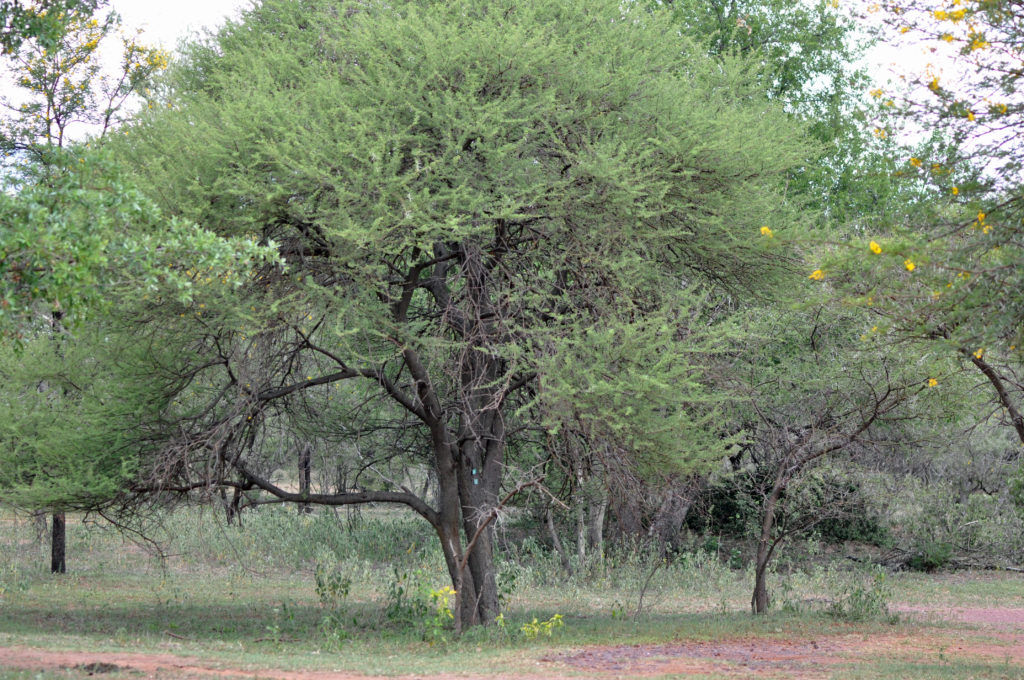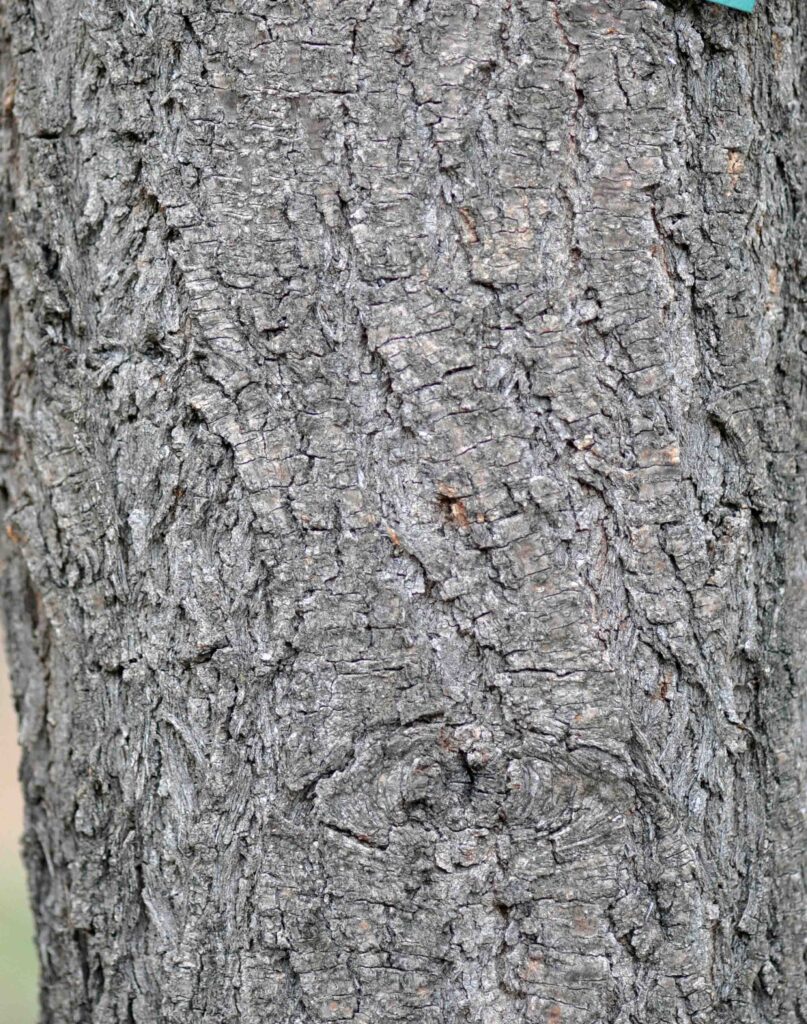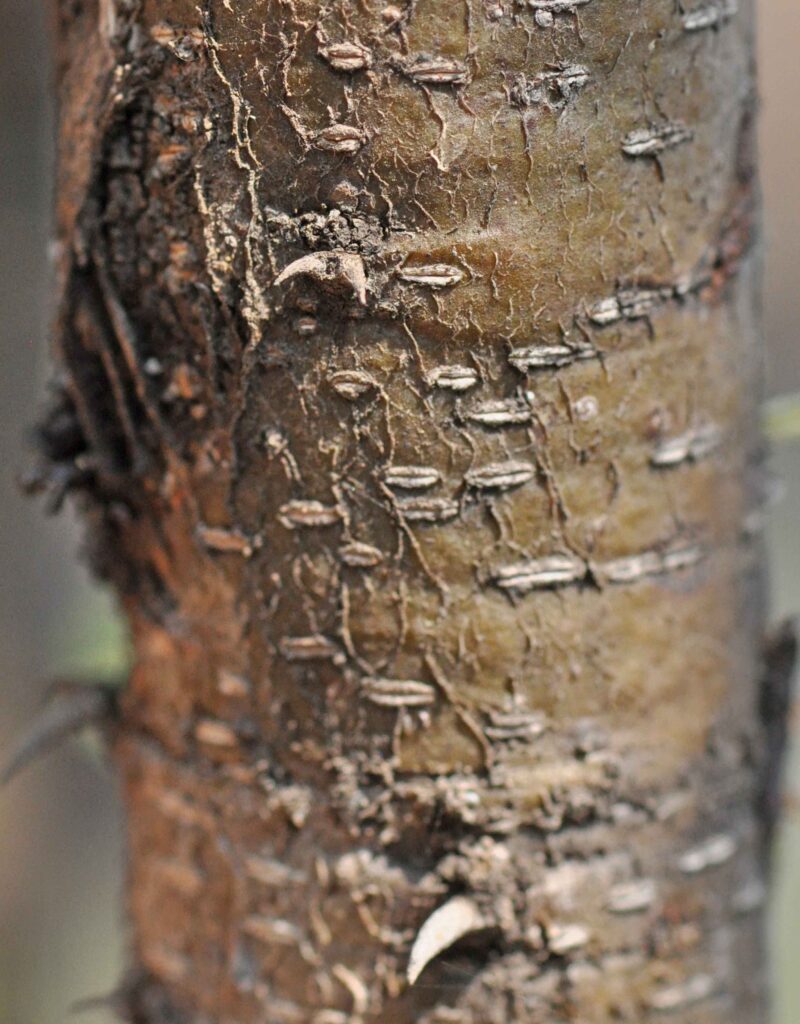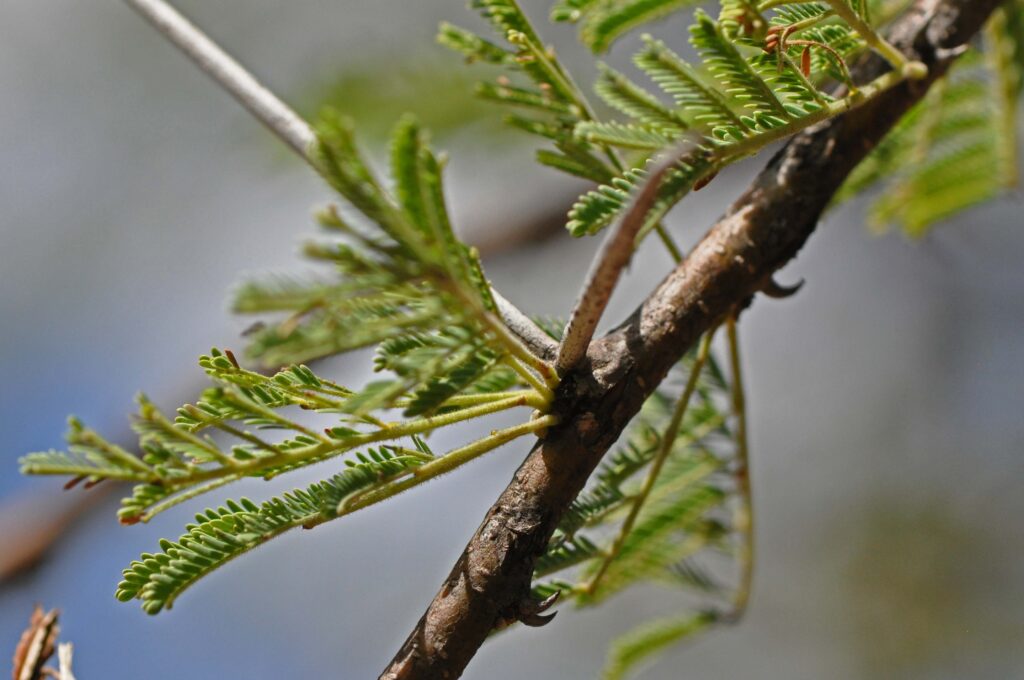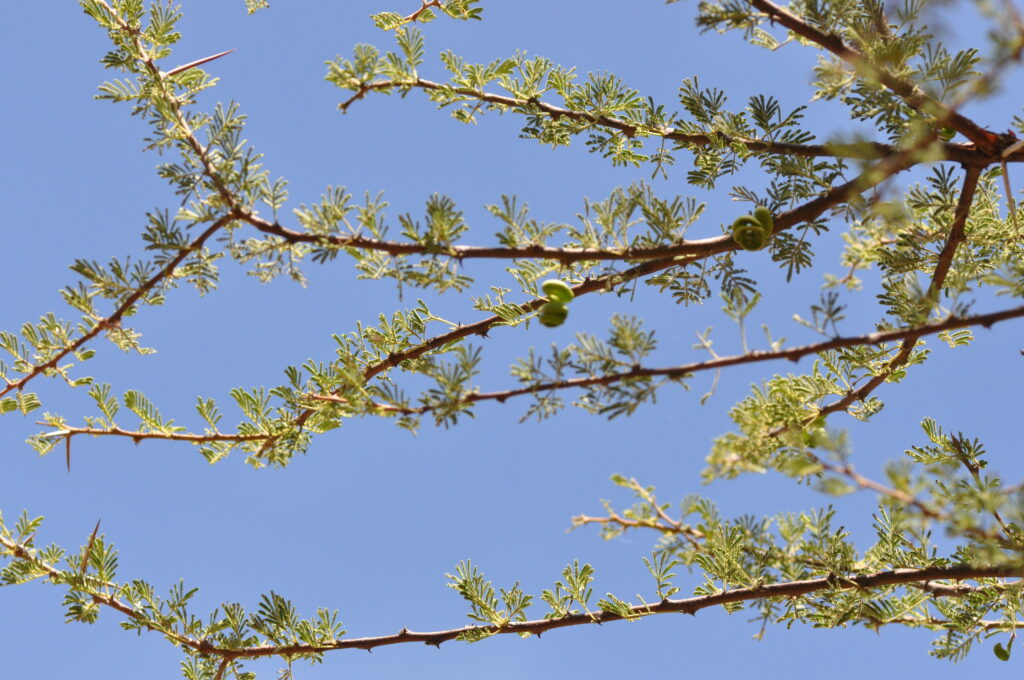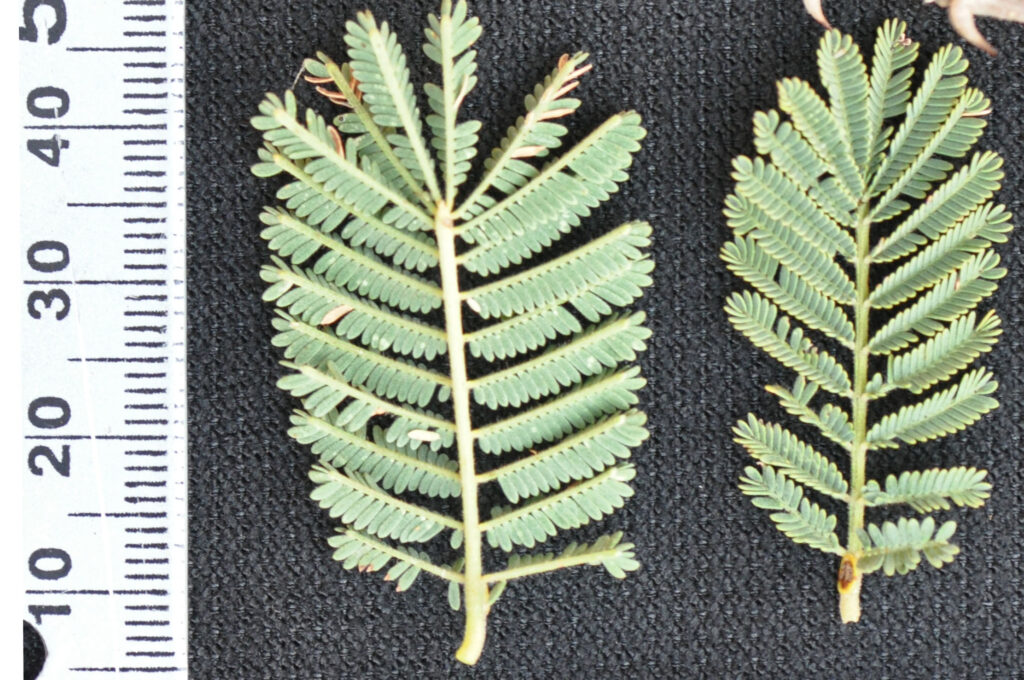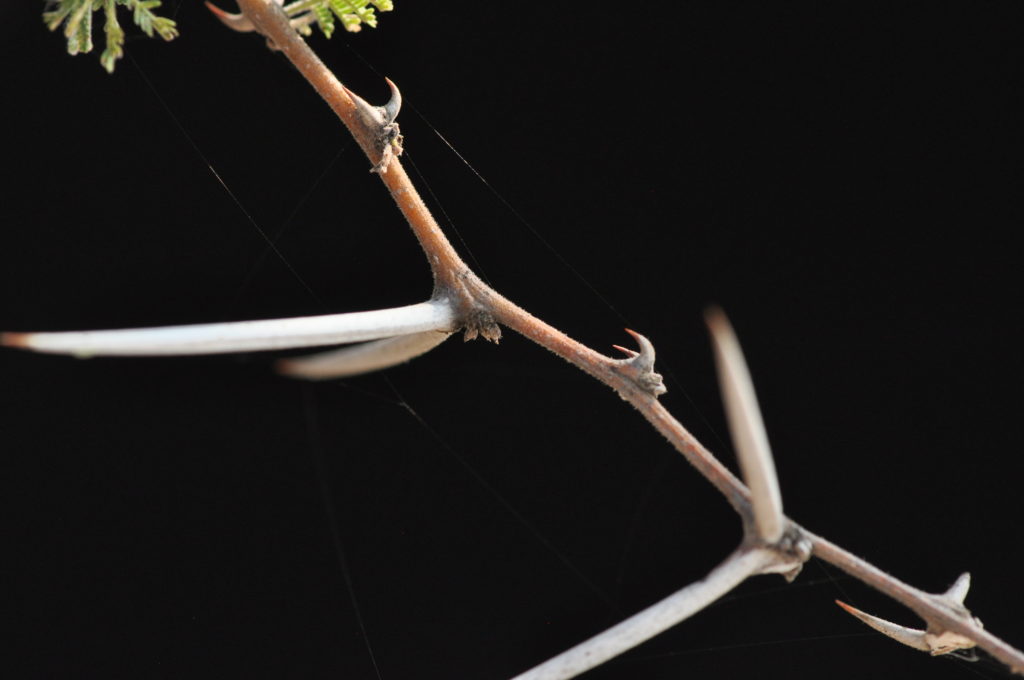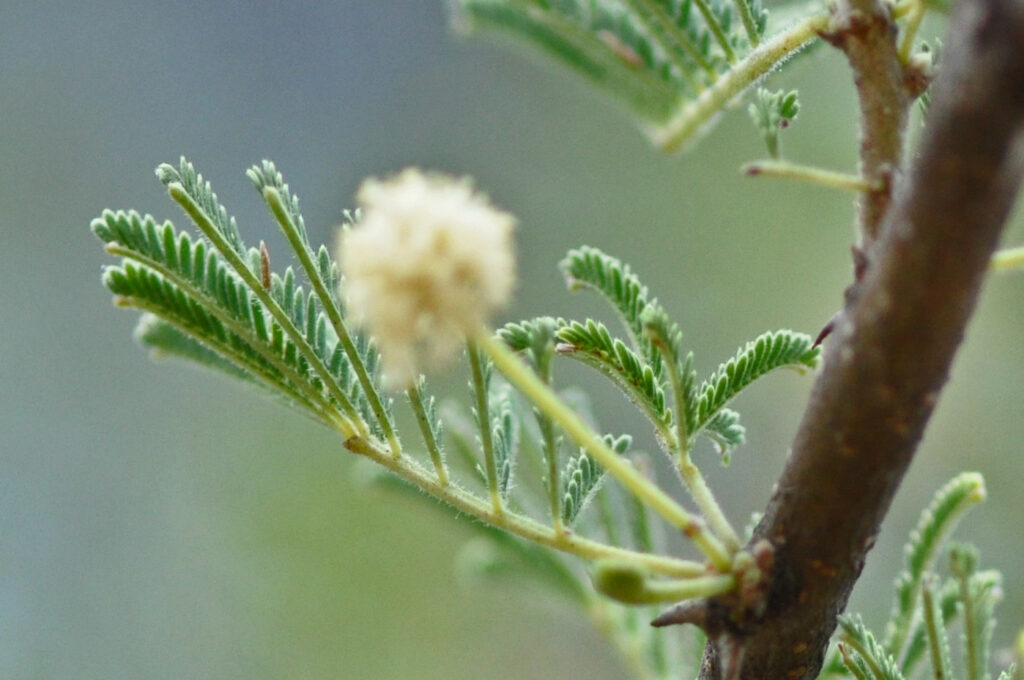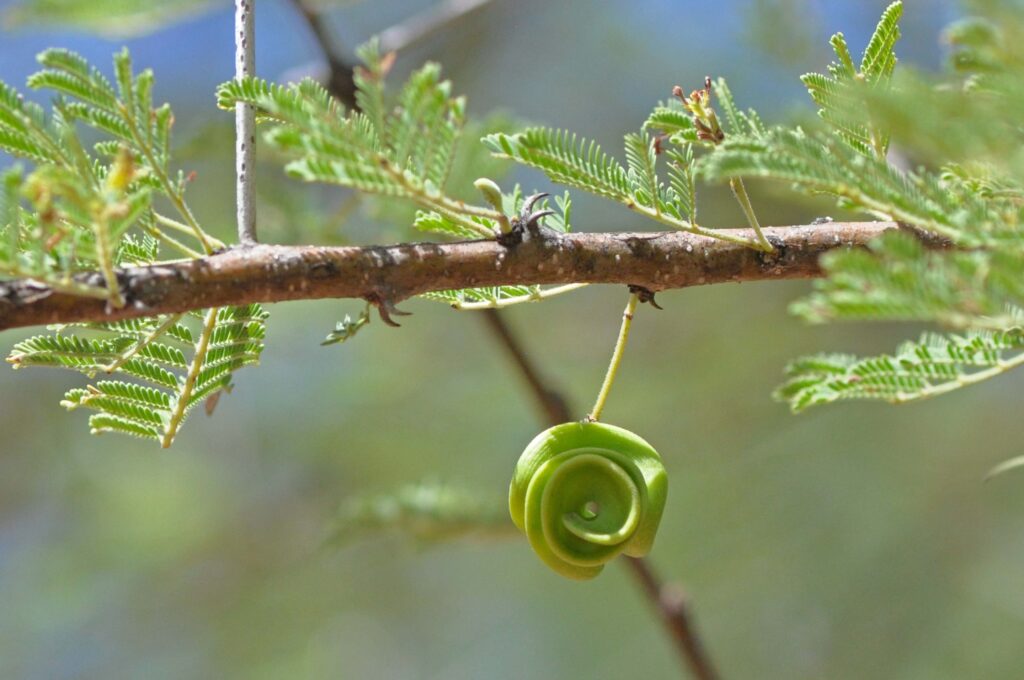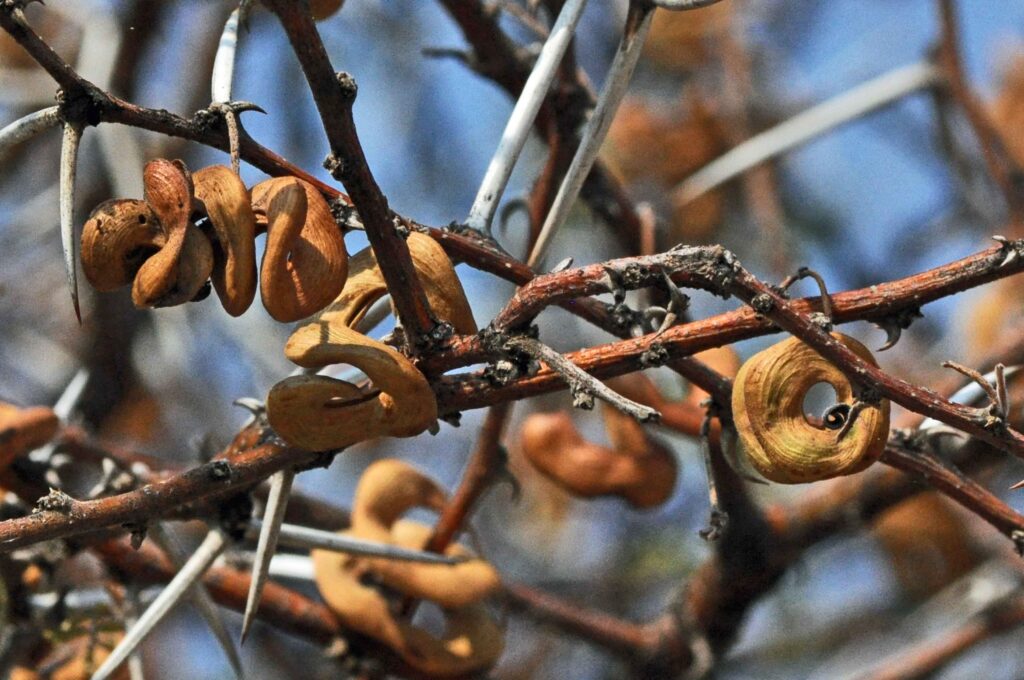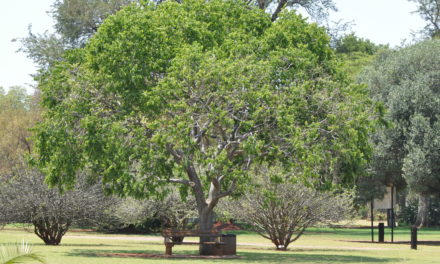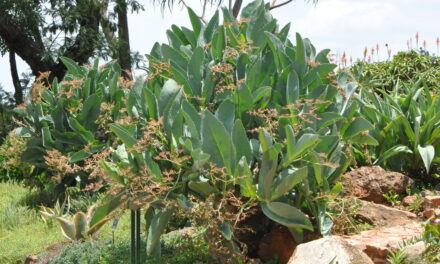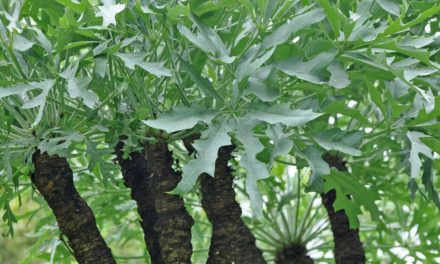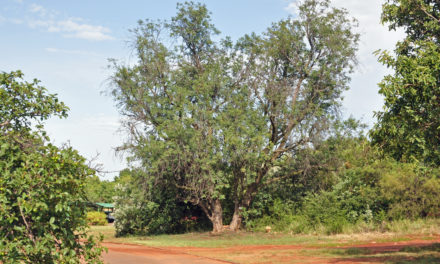Vachellia tortilis subsp. heteracantha
General Info – summary
Widespread Tree is up to 20m high (usually to 5m). Fissured bark is grey/brown. Short bipinnate Leaves have paired spinescent stipules (straight, long) and (curved, short). Tiny white Flowers in capitate spikes with many exserted stamens. Single pistil has a superior ovary. After pollen is shed, the style extends the stigma past the anthers – aiding cross-pollination. Fruit: a contorted, twisted pod + flat, dark brown seeds.
Description
Previous Names: Acacia tortilis subsp. heteracantha, Acacia heteracantha, Acacia litakunensis, Acacia maras, Acacia spirocarpoides.
SA Tree No. 188.
Common names: (Afr) Basterkameeldoring, Fynhaak, Fynhaakdoring, Fyn-haakdoring, Haakdoring, Haak-en-steek, Krulpeulakasia, Nobos, Noobos, Sambreeldoring, Tafelboom, Withaakdoring, Wit-haakdoring, Withaakkameeldoring. (Eng) Curly-pod Acacia, Israeli babool, Umbrella Thorn. (isiZulu) Isishoba, Isithwethwe. (Northern Sotho) Mosu, Moswana. (Setswana) Mosu, Mosunyana. (siSwati) Isithwethwe, Mosu, Umsasane. (Tshivenda) Muswu, Muungakhanga. (Xitsonga) Nsasane.
Family: Fabaceae or Leguminosae. (Pea, bean or legume family). After the Orchidaceae and the Asteraceae, the Fabaceae is the third largest Angiosperm (flowering plants) family with 700+ genera and close to 20 000 species. Local Tree genera on this website include Acacia (Vauchellia, Senegalia), Albizia, Bauhinia, Bolusanthus, Burkea, Calpurnia, Colophospermum, Cordyla, Cyclopia, Dichrostachys, Erythrina, Erythrophleum, Faidherbia, Indigofera, Mundulea, Peltophorum, Philenoptera, Piliostigma, Schotia and Xanthocercis. The Fabaceae are recognisable by their fruit and by their pinnately compound Leaves. Leaves may also be simple even bilobed and usually have stipules – some of which may be spinescent. Leaflets are usually entire. Flowers are bisexual and bracteate. Regular flowers usually have 4-5 sepals and the same number of petals. Irregular flowers have 4-5 sepals and 5 or less petals. Stamens have anthers that have 2 pollen sacs and there are usually at least twice the number of stamens as petals – often 10. The superior Ovary has one locule that may contain 1 or more ovules. The Stigma and Style are simple. The single carpel develops into the Fruit, which is usually a pod. The mature pods may dehisce or break into segments. Seeds vary.
Name derivation. Species of the genus Vachellia and Senegalia were considered members of the genus Acacia until 2005. New Names. The genus Vachellia was named after George H. Vachell (1789 – 1839), chaplain and plant collector in China. Here the inflorescence is capitate (head like) and spinescent stipules are present. tortilis – twisted – referring to the pods. Subsp. heteracantha – different hooked and straight thorns. Plants in the genus Senegalia usually do not have spinescent stipules and the inflorescence is usually a spike.
Conservation: National Status: L C. (Least Concern). Assessed: 2015. (Kyal. & Boatwr).
Tree
The single-stemmed Tree height is from 5-20m, but usually closer to 5m (photo 373). Smaller trees have round crowns (photo 373) whereas the larger specimens may be conspicuously flat-topped with a spread that is often greater than its height. They can also be shrubs or bushes. The initially smooth Bark has an oily appearance. With time, it becomes rough, fissured and grey (photo 367) to dark brown (photo 1008). Small branches may be hairy, olive green, red (photo 992 – under Leaves), or brown. Young branches have visible, swollen and lip-like Lenticels (a usually raised corky oval or elongated area on the plant that allows the uncontrolled interchange of gases with the environment – photo 1008).
- 373. 2014/02/18. Marakele NP. Photo: David Becking.
- 367. 2014/02/18. Marakele NP. Photo: David Becking.
- 1008. 2016/09/12. Pilanesberg NP. Photo: David Becking.
Leaves
This tree may be evergreen – weather dependent. The foliage is very fine and there are up to 6 leaves per node (photo 170). Along the branches, the relatively short, bluish grey-green Leaves are closely horizontally ranked (photo 363). These characters makes the tree densely leafy and provide a deep shade. Each leaf is up to 4,5cm long (photo 1005). This includes the shorthaired Petiole (leaf stalk). The petiole usually has a visible gland on the upper surface – close to the first pair of pinnae (photo 1005). Leaves are bipinnate (Compound: twice pinnate. The central axis or rachis has lateral pinnae “branches” not leaflets and the leaflets (pinnules) are on these “side branches”). They have 2-10 pairs of pinnae – each bearing 6 to 22 pairs of tiny (each up to 4 x 1mm) pairs of closely ranked Leaflets (pinnules) that may be hairy below. The hairy leaf Rachis (main axis bearing leaflets) is grooved on top (photo 1005). The Stipules (basal appendages of the leaf petiole) are spinescent (with spines) and develop into thin, white or brownish-paired Spines. These spines are variable. All are hooked (brown and short) or straight (white and long). Both types of spines may occur in the same (photo 992) or different locations. The common Afrikaans name for the 2 types is “haak-en-steek” means “hook-and – prick”. The short, sharply Hooked thorns are up to 0,5cm long whereas the Straight white spines may reach 10cm long. Occasionally a hooked and straight spine develop together in a pair. Some different trees have both typed of spines, but Vachellia tortilis trees also has twisted pods.
- 170. 2014/02/17. Marakele National Park. Photo: David Becking.
- 363. 2014/02/18. Marakele NP. Photo: David Becking.
- 1005. 2016/09/12. Pilanesberg NP. Photo: David Becking.
- 992. 2016/09/12. Pilanesberg NP. Photo: David Becking.
Flowers
Here each inflorescence is a cluster of flowers arranged on a stem. It is a capitate (formed like a head – photo 369) condensed Spike (simple indeterminate inflorescence with each sessile flowers on a single unbranched Pedicel – the stalk of a single flower). Collectively each inflorescence appears as a creamy to yellowish sphere that is up to 2,5cm wide. The one hairy Peduncle (stalk of a cluster of flowers) is up to 1,4cm long (light green in photo 369). The peduncle has an involucre (one or more whorls of small leaves or bracts) standing below the spike and located part of the way up the peduncle (photo 369). The strongly sweet-scented Flowers may appear in mass. When they do, they cover the whole tree. All flowers are bisexual and actinomorphic (Regular, symmetrical. Flowers are vertically divisible into similar halves by more than 1 plane passing through the axis). The Calyx is up to 2mm long and interior to this is the 2,6mm long Corolla. The many exserted (here projecting beyond the calyx and corolla) Stamens give the flower its creamy-white colour. There is a single Pistil (a unit of the Gynoecium, the female element of the flower, composed of the Ovary, Style and Stigma) and the superior Ovary has a single locule. A single filiform (thread or filament like) Style eventually protrudes past the anthers and ends in a Stigma – which only now becomes receptive to pollen. This occurs after the shedding of the flowers own pollen. This late development helps to ensure cross-pollination. (Oct-Feb).
- 369. 2014/02/18. Marakele NP. Photo: David Becking.
Fruit
The small Fruit is a usually hairless Pod. It is initially green (photo 167) and becomes golden brown, flat and up to 9mm wide. Each pod is smooth and often curled into a distinctive corkscrew spiral (photos 167 – initially green & 995 – finally brown). The fallen pod is indehiscent or tardily dehiscent on the ground. The flat dark brown Seeds have a distinct horseshoe-shaped area on one surface. Many animals eat the protein rich reachable pods and fallen pods. These seeds pass unharmed through their digestive system – thus aiding dispersal. (Feb-Aug).
- 167. 2014/02/17. Marakele NP. Photo: David Becking.
- 995. 2016/09/12. Pilanesberg. Photo: David Becking.
Distribution & Ecology
In South Africa, this woodland, bushveld tree is almost as common as Vachellia karroo. Vachellia tortilis is a characteristic tree of red Kalahari sand in the Northern Cape and Namibia. This tree is common on heavy soils. The trees grow in deciduous woodlands and wooded grasslands. Each tree is a survivor that can tolerate dry times. As a result, they are common in low rainfall areas. Trees are most common in the Northeast of SA and may grow in alkaline, as well as sandy or rocky soils or even beach sand. They usually occur at medium altitudes and temperature ranges between 0-50 degrees Celsius. The Pods are rich in protein and baboons, monkeys, elephants and giraffe eat young pods. Giraffe, monkeys, antelope and baboons all browse the nutritious Leaves. Elephants also consume the Bark. The Spines become hard and vicious with age, and this may help prevent overgrazing. Trees occur naturally in the Northern Cape, North West, Free State, northern KwaZulu-Natal – e.g. in Mkuze in dry thornveld , Gauteng, Mpumalanga and Limpopo. They also occur in Eswatini (Swaziland), Zimbabwe e.g. Matetsi – Near the Victoria Falls, Namibia – near Windhoek and further north into tropical Africa – including the Lake Manyara National Park in Tanzania. In Mozambique, this tree occurs mainly in the south and North West. The branch and spine arrangement of these trees make this a good tree for nesting Birds. It is also a perching place for big birds like Secretary Birds and Vultures. Atmospheric nitrogen fixation occurs in the roots. This eventually benefits all life in the area. An additional subspecies Acacia tortilis subsp. spirocarpa occurs in the North West. Here the pods are elongated – not spiralled.
Ethnobotany
The presence of these trees is an indicator of sweet Grass, which is good for cattle farmers. Water seasoning of Wood in dry weather decreases attack by borers. The tree has strong Wood that is used for fuel, fence posts, furniture and implement making. The light sapwood is soft and the heartwood is red. Growth rings are distinct in stem cross-sections. The exuded edible Gum (a water-soluble sugary polysaccharide) helps to seal wounds and prevent bacteria and fungi infections. It also helps to prevent trees from freezing). Tannin is extractable from the Bark. The tree is hardy and drought resistant. Local medicine makes use of this tree. The twisted pods and 2 thorn types are distinguishing characteristics. Domestic animals consume the pods and leaves. The trees grows easily but slowly from Seeds and do best in full sun. Young trees are frost sensitive. The leaves have closely ranked leaflets that provide a useful shade but this does tend to prevent grass from growing close to the trunk. This tree is planted as a soil stabilizer for reclaiming dunes. Noah may have built his arc out of wood from this tree.
References
Boon, R. 2010. Pooley’s Trees of eastern South Africa. Flora and Fauna Publications Trust, Durban.
Burrows, J.E., Burrows, S.M., Lotter, M.C. & Schmidt, E. Trees and Shrubs Mozambique. Publishing Print Matters (Pty) Ltd. Noordhoek, Cape Town.
Coates Palgrave, M. 2002. Keith Coates Palgrave Trees of Southern Africa, edn 3. Struik, Cape Town.
Foden, W. & Potter, L. 2005. Vachellia tortilis (Forssk.) Gallaso & Banfi subsp. heteracantha (Burch.) Kyal. & Boatwr. National Assessment: Red List of South African Plants version . Accessed on 2025/04/23.
Lawrence, G. H. M, 1951. Taxonomy of Vascular Plants. The Macmillan Company, New York. Tenth Printing 1965.
Ross, J. H. A conspectus of the African Acacia Species. 1979. Botanical Research Institute.
Palmer, E. & Pitman, N. 1972. Trees of southern Africa. Balkema, Amsterdam, Cape Town.
Schmidt, S. Lotter, M. & McCleland, W. 2002. Trees and Shrubs of Mpumalanga and the Kruger National Park. Jacana, Johannesburg.
van Wyk, B. & van Wyk, P. 1997 Field guide to Trees of Southern Africa. Struik, Cape Town.
https://en.wikipedia.org/wiki/Vachellia_tortilis#Distribution_and_growing_conditions
http://pza.sanbi.org/vachellia-tortilis
http://www.krugerpark.co.za/africa_umbrella_thorn.html
http://www.krugerpark.co.za/Kruger_Park_Reference_Guide-travel/african-tree-guide.html
http://www.plantzafrica.com/plantab/acaciatortilis.htm
http://www.worldagroforestry.org/treedb2/speciesprofile.php?Spid=118
http://waynesword.palomar.edu/plaug99.htm
http://posa.sanbi.org/flora/browse.php?src=SP
http://www.calflora.net/botanicalnames/pageV.html

